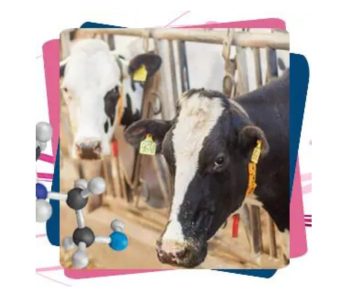Choline: An Ally Against Fatty Liver and Ketosis
The ability of dairy cows to adapt to negative energy balance (NEB) during the early days of lactation is a crucial factor in milk production since demands cannot be met by food intake alone (Herdt et al., 2000).
One of these disorders is hyperketonemia or ketosis, which develops due to a poor adaptive response to negative energy balance when the liver is saturated with the accumulation of non-esterified fatty acids (NEFAs).
Due to the low energy intake during the transition stage, the body starts mobilizing body fat reserves, increasing the concentration of NEFAs and beta-hydroxybutyrate (BHBA) in the blood (Li et al., 2016).
This metabolic disorder can be classified based on blood BHBA concentrations:
A significant consequence of ketosis in cattle is a reduction in milk production, leading to a potential loss of up to 7% over the entire lactation period.
Another significant consequence of ketosis is the culling of animals, with documented reports indicating a threefold rise in the risk of disposal for animals exhibiting ketosis.
In terms of reproduction, it has been demonstrated that blood BHBA concentrations surpassing 1.2 mmol/l during the initial week postpartum can:
(Otzel & McGuirk, 2010)
In general, the costs stemming from ketosis include:
The economic impact of ketosis amounts to €256.71 per animal (Deniz et al., 2020).
| Therefore, it is crucial to stimulate liver function to prevent these disorders, and this is where choline plays a fundamental role. |
Choline is an essential nutrient for ruminants, participating in various physiological processes such as lipid metabolism and transport.
Phosphatidylcholine plays a crucial role as a vital component in the formation of low-density lipoproteins (VLDL), responsible for removing fats from the liver. This function is particularly crucial during the transition period when the cow experiences a decline in body condition score(BCS) (Yao & Vance, 1988).
Every cow experiences a decrease in body condition score (BCS) during the initial 30 days in milk (DIM), and the criterion for recognizing BCS loss is in the range of 0.5% to 0.75%. This equates to 40.55 kg of fat and protein (with one unit averaging 70 kg, depending on the cow’s size).
Graph 1. Concentration of phosphatidylcholine in plasma of dairy cows around calving (Imhaslv et al., 2015).
The liver weighs 9 kg and can accumulate more than 450 g of fat the day after calving(Drackley, 2001). A one-point decrease in body condition score will result in 4.5 – 5.5 kg of fat accumulating in the liver! |
It is worth mentioning that, while the animal is in a state of negative energy balance (NEB), choline levels in the blood are at their lowest concentrations during the initial weeks of production (Arshad et al., 2020).
Hence, it is crucial to provide the animal with a protected choline source to prevent its degradation by the microbial population, enabling absorption in the intestine.
Protected choline:
(Jayapraksh et al., 2016)
Findings from the same study indicate that, through the supplementation of protected choline, milk production can see an increase of up to 1.6 kg/day (even 2 kg/day), particularly when paired with protected methionine.
Graph 2. Lactation curve of cows supplemented with and without protected choline (Zenobi et al., 2018 – JDS 101:1088).
Graph 3. Quality (brix) and quantity of colostrum in cows supplemented with choline and without choline (Zenobi et al., 2018 – JDS 101_1088).
|
Bibliographical references
Drackley, J. K. 1999. ADSA Foundation Scholar Award: Biology of dairy cows during the transition period: The final frontier? J. Dairy Sci. 82:2259–2273.
Herdt, T. H. 2000. Ruminant adaptation to negative energy balance. Influences on the etiology of ketosis and fatty liver. Vet. Clin. North Am. Food Anim. Pract. 16:215–230.
J. A. A. McArt, D. V. Nydam, and G. R. Oetzel 2012. Epidemiology of subclinical ketosis in early lactation dairy cattle.
J. M. Bollatti, M. G. Zenobi, B. A. Barton,2 C. R. Staples, and J. E. P. Santos 2019. Responses to rumen-protected choline in transition cows do not depend on prepartum body condition.
Puppel, K., Gołębiewski, M., Solarczyk, P., Grodkowski, G., Slósarz, J., Kunowska-Slósarz, M., … & Kuczyńska, B. (2019). The relationship between plasma β-hydroxybutyric acid and conjugated linoleic acid in milk as a biomarker for early diagnosis of ketosis in postpartum Polish Holstein-Friesian cows. BMC veterinary research,
U. Arshad, M. G. Zenobi, C. R. Staples, and J. E. P. Santos 2019. Meta-analysis of the effects of supplemental rumen-protected choline during the transition period on performance and health of parous dairy cows.
Zenobi, M. G., R. Gardinal, J. E. Zuniga, L. K. Mamedova, B. J. Bradford, J. P. Driver, B. A. Barton, J. E. P. Santos, C. D. Nelson, and C. R. Staples. 2020. Effect of prepartum energy intake and supplementation with ruminally-protected choline on innate and adaptive immunity of multiparous Holstein cows. J. Dairy Sci. 103:2200–2216
Zenobi, M. G., T. L. Scheffler, J. E. Zuniga, M. B. Poindexter, S. R. Campagna, H. F. Castro Gonzalez, A. T. Farmer, B. A. Barton, J. E. P.
Santos, and C. R. Staples. 2018. Feeding increasing amounts of ruminally protected choline decreased fatty liver in nonlactating, pregnant Holstein cows in negative energy status. J. Dairy Sci. 101:5902–5923.
